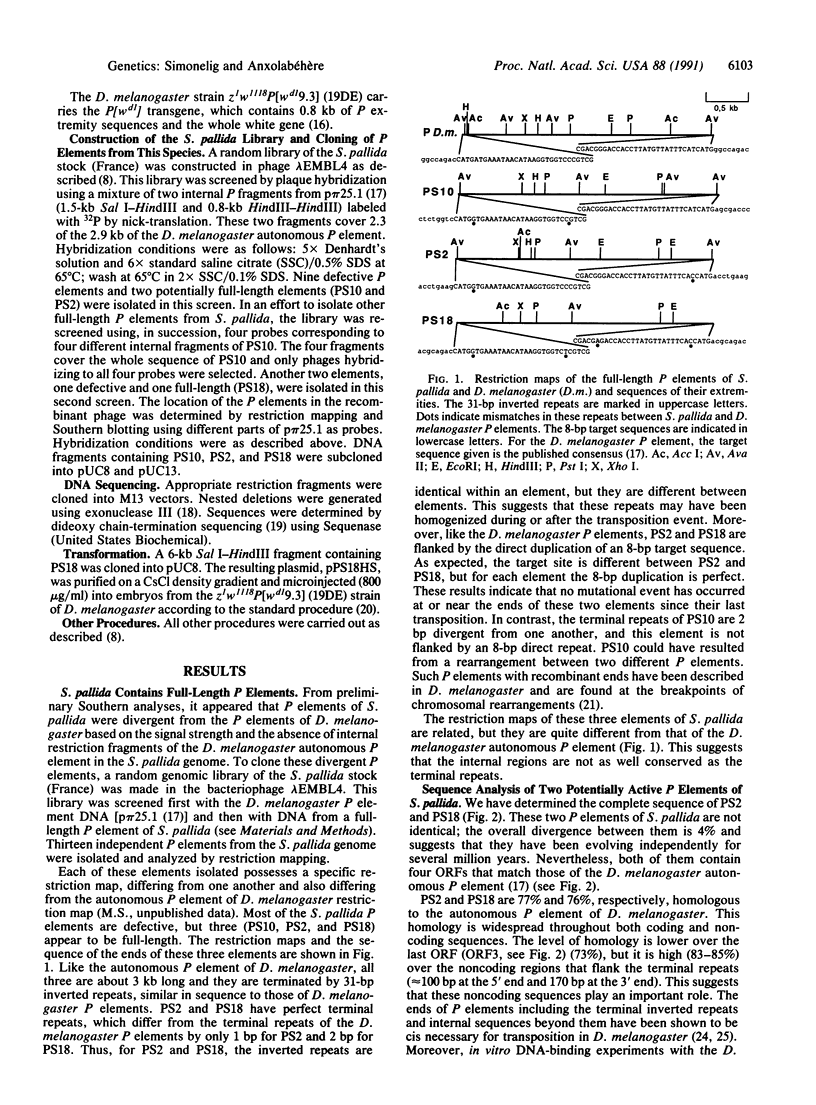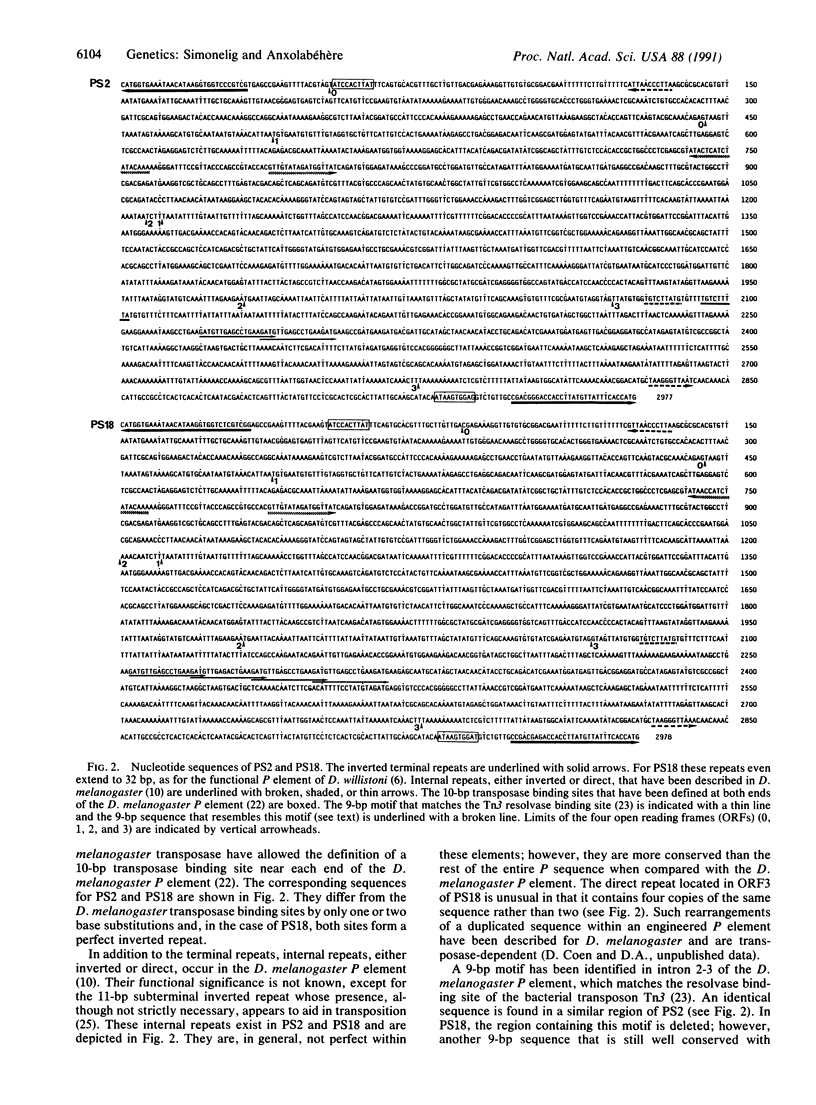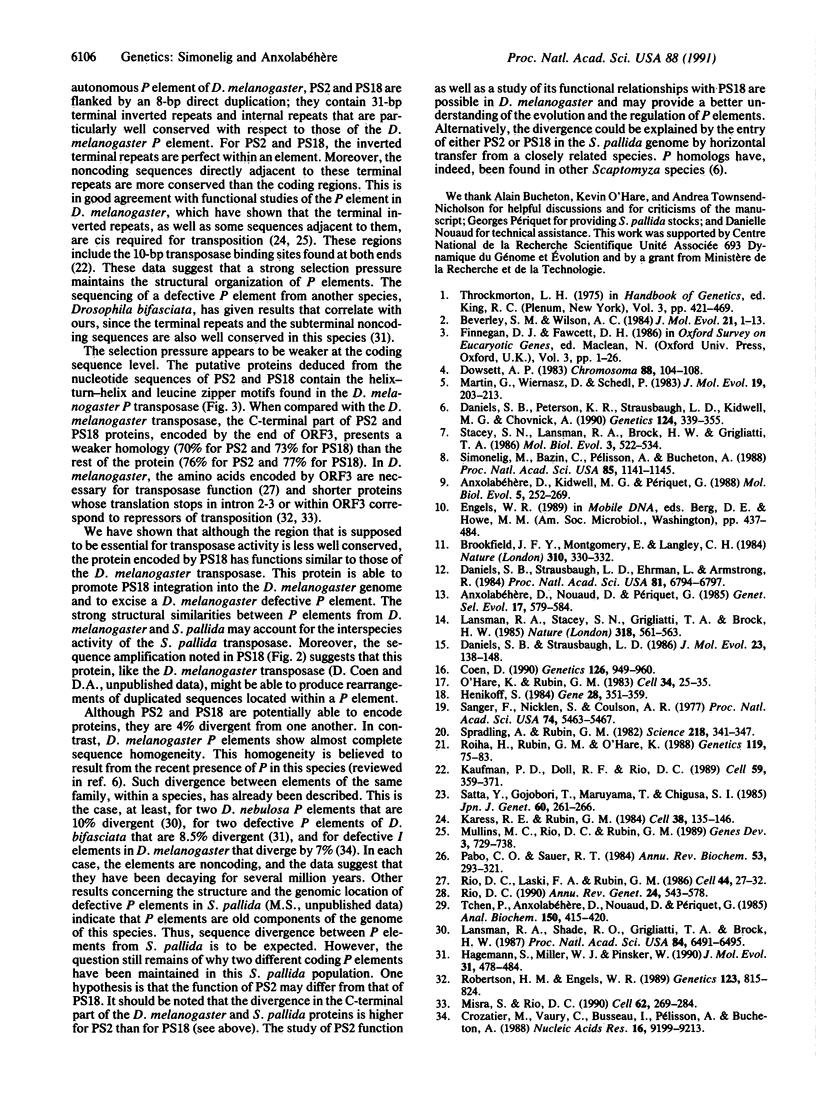Abstract
Several results suggest that P elements have recently invaded natural populations of Drosophila melanogaster after a horizontal transfer from another species. The donor species is thought to come from the willistoni group, which contains P elements very homologous to those of D. melanogaster. However, more divergent P elements are present in many other Drosophilidae species. We have analyzed such elements from Scaptomyza pallida, a species phylogenetically distant to D. melanogaster. We report here the isolation of two coding P elements from S. pallida (PS2 and PS18) that are 4% divergent from one another. At least one of these elements (PS18) is active since it is able to transpose in D. melanogaster and to mobilize a D. melanogaster defective P element, even though its nucleotide sequence is 24% divergent from the canonical P element of D. melanogaster. To our knowledge, a P element that is active and strongly divergent from the D. melanogaster P element has not been reported previously. Sequence comparison between the complete P elements of D. melanogaster and S. pallida reveals that the structural characteristics are maintained: PS2 and PS18 contain terminal inverted repeats and internal repeats very similar to those of the D. melanogaster P element. In addition, the noncoding regions cis necessary for the transposition are more conserved than the coding sequences. Two domains found in the D. melanogaster P transposase (helix-turn-helix and leucine zipper) are well conserved in the putative proteins encoded by PS2 and PS18. This study provides insights into which parts of P elements are functionally important and correlates with functional studies of the P element in D. melanogaster.
Full text
PDF




Images in this article
Selected References
These references are in PubMed. This may not be the complete list of references from this article.
- Anxolabéhère D., Kidwell M. G., Periquet G. Molecular characteristics of diverse populations are consistent with the hypothesis of a recent invasion of Drosophila melanogaster by mobile P elements. Mol Biol Evol. 1988 May;5(3):252–269. doi: 10.1093/oxfordjournals.molbev.a040491. [DOI] [PubMed] [Google Scholar]
- Beverley S. M., Wilson A. C. Molecular evolution in Drosophila and the higher Diptera II. A time scale for fly evolution. J Mol Evol. 1984;21(1):1–13. doi: 10.1007/BF02100622. [DOI] [PubMed] [Google Scholar]
- Brookfield J. F., Montgomery E., Langley C. H. Apparent absence of transposable elements related to the P elements of D. melanogaster in other species of Drosophila. 1984 Jul 26-Aug 1Nature. 310(5975):330–332. doi: 10.1038/310330a0. [DOI] [PubMed] [Google Scholar]
- Coen D. P element regulatory products enhance zeste repression of a P[white duplicated] transgene in Drosophila melanogaster. Genetics. 1990 Dec;126(4):949–960. doi: 10.1093/genetics/126.4.949. [DOI] [PMC free article] [PubMed] [Google Scholar]
- Crozatier M., Vaury C., Busseau I., Pelisson A., Bucheton A. Structure and genomic organization of I elements involved in I-R hybrid dysgenesis in Drosophila melanogaster. Nucleic Acids Res. 1988 Oct 11;16(19):9199–9213. doi: 10.1093/nar/16.19.9199. [DOI] [PMC free article] [PubMed] [Google Scholar]
- Daniels S. B., Peterson K. R., Strausbaugh L. D., Kidwell M. G., Chovnick A. Evidence for horizontal transmission of the P transposable element between Drosophila species. Genetics. 1990 Feb;124(2):339–355. doi: 10.1093/genetics/124.2.339. [DOI] [PMC free article] [PubMed] [Google Scholar]
- Daniels S. B., Strausbaugh L. D., Ehrman L., Armstrong R. Sequences homologous to P elements occur in Drosophila paulistorum. Proc Natl Acad Sci U S A. 1984 Nov;81(21):6794–6797. doi: 10.1073/pnas.81.21.6794. [DOI] [PMC free article] [PubMed] [Google Scholar]
- Daniels S. B., Strausbaugh L. D. The distribution of P-element sequences in Drosophila: the willistoni and saltans species groups. J Mol Evol. 1986;23(2):138–148. doi: 10.1007/BF02099908. [DOI] [PubMed] [Google Scholar]
- Dowsett A. P. Closely related species of Drosophila can contain different libraries of middle repetitive DNA sequences. Chromosoma. 1983;88(2):104–108. doi: 10.1007/BF00327329. [DOI] [PubMed] [Google Scholar]
- Hagemann S., Miller W. J., Pinsker W. P-related sequences in Drosophila bifasciata: a molecular clue to the understanding of P-element evolution in the genus Drosophila. J Mol Evol. 1990 Dec;31(6):478–484. doi: 10.1007/BF02102074. [DOI] [PubMed] [Google Scholar]
- Henikoff S. Unidirectional digestion with exonuclease III creates targeted breakpoints for DNA sequencing. Gene. 1984 Jun;28(3):351–359. doi: 10.1016/0378-1119(84)90153-7. [DOI] [PubMed] [Google Scholar]
- Karess R. E., Rubin G. M. Analysis of P transposable element functions in Drosophila. Cell. 1984 Aug;38(1):135–146. doi: 10.1016/0092-8674(84)90534-8. [DOI] [PubMed] [Google Scholar]
- Kaufman P. D., Doll R. F., Rio D. C. Drosophila P element transposase recognizes internal P element DNA sequences. Cell. 1989 Oct 20;59(2):359–371. doi: 10.1016/0092-8674(89)90297-3. [DOI] [PubMed] [Google Scholar]
- Lansman R. A., Shade R. O., Grigliatti T. A., Brock H. W. Evolution of P transposable elements: sequences of Drosophila nebulosa P elements. Proc Natl Acad Sci U S A. 1987 Sep;84(18):6491–6495. doi: 10.1073/pnas.84.18.6491. [DOI] [PMC free article] [PubMed] [Google Scholar]
- Martin G., Wiernasz D., Schedl P. Evolution of Drosophila repetitive-dispersed DNA. J Mol Evol. 1983;19(3-4):203–213. doi: 10.1007/BF02099967. [DOI] [PubMed] [Google Scholar]
- Misra S., Rio D. C. Cytotype control of Drosophila P element transposition: the 66 kd protein is a repressor of transposase activity. Cell. 1990 Jul 27;62(2):269–284. doi: 10.1016/0092-8674(90)90365-l. [DOI] [PubMed] [Google Scholar]
- Mullins M. C., Rio D. C., Rubin G. M. cis-acting DNA sequence requirements for P-element transposition. Genes Dev. 1989 May;3(5):729–738. doi: 10.1101/gad.3.5.729. [DOI] [PubMed] [Google Scholar]
- O'Hare K., Rubin G. M. Structures of P transposable elements and their sites of insertion and excision in the Drosophila melanogaster genome. Cell. 1983 Aug;34(1):25–35. doi: 10.1016/0092-8674(83)90133-2. [DOI] [PubMed] [Google Scholar]
- Pabo C. O., Sauer R. T. Protein-DNA recognition. Annu Rev Biochem. 1984;53:293–321. doi: 10.1146/annurev.bi.53.070184.001453. [DOI] [PubMed] [Google Scholar]
- Rio D. C., Laski F. A., Rubin G. M. Identification and immunochemical analysis of biologically active Drosophila P element transposase. Cell. 1986 Jan 17;44(1):21–32. doi: 10.1016/0092-8674(86)90481-2. [DOI] [PubMed] [Google Scholar]
- Rio D. C. Molecular mechanisms regulating Drosophila P element transposition. Annu Rev Genet. 1990;24:543–578. doi: 10.1146/annurev.ge.24.120190.002551. [DOI] [PubMed] [Google Scholar]
- Robertson H. M., Engels W. R. Modified P elements that mimic the P cytotype in Drosophila melanogaster. Genetics. 1989 Dec;123(4):815–824. doi: 10.1093/genetics/123.4.815. [DOI] [PMC free article] [PubMed] [Google Scholar]
- Roiha H., Rubin G. M., O'Hare K. P element insertions and rearrangements at the singed locus of Drosophila melanogaster. Genetics. 1988 May;119(1):75–83. doi: 10.1093/genetics/119.1.75. [DOI] [PMC free article] [PubMed] [Google Scholar]
- Sanger F., Nicklen S., Coulson A. R. DNA sequencing with chain-terminating inhibitors. Proc Natl Acad Sci U S A. 1977 Dec;74(12):5463–5467. doi: 10.1073/pnas.74.12.5463. [DOI] [PMC free article] [PubMed] [Google Scholar]
- Simonelig M., Bazin C., Pelisson A., Bucheton A. Transposable and nontransposable elements similar to the I factor involved in inducer-reactive (IR) hybrid dysgenesis in Drosophila melanogaster coexist in various Drosophila species. Proc Natl Acad Sci U S A. 1988 Feb;85(4):1141–1145. doi: 10.1073/pnas.85.4.1141. [DOI] [PMC free article] [PubMed] [Google Scholar]
- Spradling A. C., Rubin G. M. Transposition of cloned P elements into Drosophila germ line chromosomes. Science. 1982 Oct 22;218(4570):341–347. doi: 10.1126/science.6289435. [DOI] [PubMed] [Google Scholar]
- Stacey S. N., Lansman R. A., Brock H. W., Grigliatti T. A. Distribution and conservation of mobile elements in the genus Drosophila. Mol Biol Evol. 1986 Nov;3(6):522–534. doi: 10.1093/oxfordjournals.molbev.a040413. [DOI] [PubMed] [Google Scholar]
- Tchen P., Anxolabehere D., Nouaud D., Périquet G. Hybridization on squashed flies: a method to detect gene sequences in individual Drosophila. Anal Biochem. 1985 Nov 1;150(2):415–420. doi: 10.1016/0003-2697(85)90530-5. [DOI] [PubMed] [Google Scholar]




